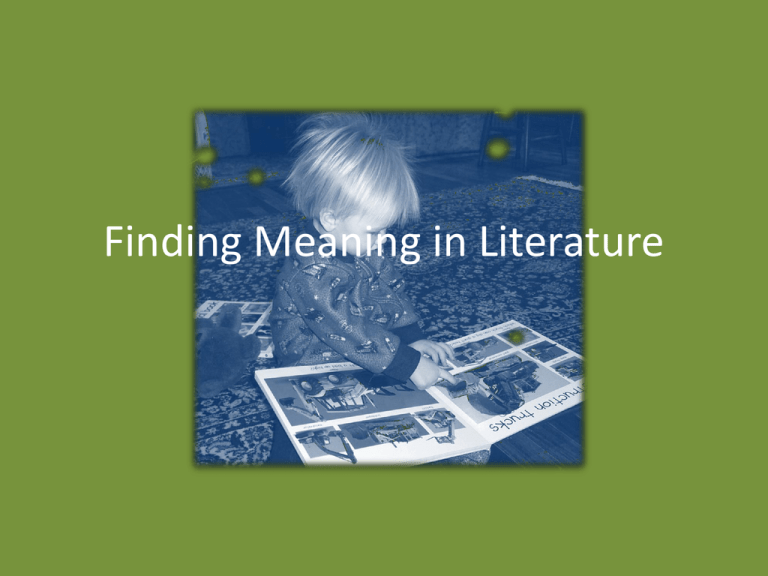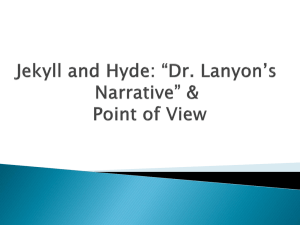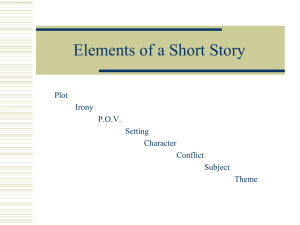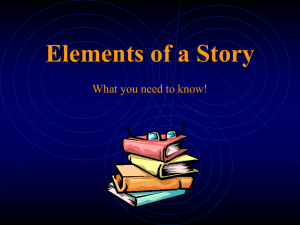Finding Meaning in Literature
advertisement

Finding Meaning in Literature How do I figure out meaning in literature? Analysis looks at an entire work through one or more of its parts. Explication is used in analysis on a part of the literary work in a thorough, sustained, meticulous, systematic way. Exposition is background information regarding the setting, characters, plot, often found at the beginning of fiction. Plot is the sequence of events that moves the story along. Events come out of, reveal, and influence characters. Plot is movement A. Look at beginnings and endings because fiction always involves movement. B. Look at the situation of the major character(s) at the beginning and ending of the story. The nature of the changes suggests meaning. C. Note the changes in all the important stages. How and why do the characters achieve change? D. What works AGAINST movement in the story? What do serious complications show about the story? E. Consider the various lines of action. Separate them and determine how they are connected. • Conflict is the problem to be solved in the story. • Internal conflict is person versus self. • External conflict is person versus person, person versus society, person versus nature, person versus technology, person versus fate. Rising action is the movement of plot toward conflict resolution. Complication is a plot event that shows one of the conflicts; it is part of the rising action. An example of complication is when Aslan is killed in The Lion, the Witch, and the Wardrobe. Climax • The point in the story with the highest excitement. The conflict is about to be resolved. For example, when Dre wins the championship in The Karate Kid. Denouement • Also known as the resolution, it is the unraveling of complications at the story’s end. Some works of fiction do not have this. Foreshadowing and Flashback • Foreshadowing is when the author provides clues concerning what will happen in the plot. Dreams are a great example of this. • Flashback involves something that has occurred before the story’s beginning. Character is a function of two forces: individuality and archetypes (basic types of characters like heroes, villains, wise elders) . A. If characters change, the HOW and WHY are key. B. What do characters learn or not learn by the denouement? C. What lesson does the reader learn due to the character? D. Questions to ask: Which character is most interesting and why? What purpose do minor characters serve? In which ways does the author reveal character? Which characters are believable—if any? How and why do characters change? With which character do you most identify or sympathize? Direct characterization --How the author describes the character (height, age, eyes, clothing) --What other characters say about the character (“He’s mean!” “She’s friendly.”) The glassy-eyed creature looked like a crazed Rastafarian in a Star Wars sequel. Indirect characterization --What a character says --What a character does --What a character thinks --How a character interacts with other characters --Reader must infer “I do not want to fight, but I must protect my people and honor my family’s name.” Protagonist • Main character who tries to reach a goal and keeps the story going. NOT ALWAYS A “GOOD GUY.” Most complications involve setbacks toward achieving the goal. Antagonist • Main character or force that tries to keep the protagonist from reaching the goal. Point of View: The Narrator • First person—The narration of the entire novel (not the dialogue) is in first person (I, me, my). • Ex. “TRUE! nervous, very, very dreadfully nervous I had been and am; but why WILL you say that I am mad? The disease had sharpened my senses, not destroyed, not dulled them. Above all was the sense of hearing acute. I heard all things in the heaven and in the earth” (Edgar Allen Poe). • The reader knows what the narrator is thinking. It’s as if the narrator is telling the reader what he or she has seen. Third-Person Point of View • Third person means the narrator tells the story without using I, me, my (do not look at anything inside quotation marks. • Ex. “Della finished her cry and attended to her cheeks with the powder rag. She stood by the window and looked out dully at a gray cat walking a gray fence in a gray backyard. Tomorrow would be Christmas Day, and she had only $1.87 with which to buy Jim a present” (O. Henry). Third-Person Point of View Third-person limited—Reader knows what only one character in the story is thinking. Third-person omniscient—Reader knows what several characters in the story are thinking. Third-person objective—Character knows what nobody is thinking (like a news story). Questions to ask regarding point of view: A. Whose side, if anyone’s, does the narrator take? B. What is the narrator telling you? C. What ISN’T the narrator telling you? D. If the narrator isn’t telling you everything, why not? E. How reliable is this narrator? F. Why did the author use this point of view? Setting is the time and place of action Setting includes the description of buildings, weather, time of day, time of year, geographical information. Ex. Day had broken cold and gray, exceedingly cold and gray, when the man turned aside from the main Yukon trail and climbed the high earth-bank, where a dim and little-travelled trail led eastward through the fat spruce timberland. It was a steep bank, and he paused for breath at the top, excusing the act to himself by looking at his watch. It was nine o'clock. There was no sun nor hint of sun, though there was not a cloud in the sky. It was a clear day, and yet there seemed an intangible pall over the face of things, a subtle gloom that made the day dark, and that was due to the absence of sun” (Jack London). Setting may be an important factor in determining atmosphere and limits for the story. A. Be sure to look at the connotation of words. B. Questions: What is the relation between setting, plot and characters? What would be lost if the descriptions of setting were deleted? How crucial is the particular setting that is used? Three Types of Irony Verbal– what is said and what is meant. • Dramatic—contrast between what is real and what character thinks is real • Situational—contrast between what should be and what is or what happens and what reader thinks should happen. Which type of irony? • “Nice hat,” she said as she looked at the ugliest had she had ever seen. • “Of course there is such thing as the tooth fairy,” said the little girl. • “Give peace a chance,” said the protester as she punched the officer in the stomach. • “Nobody came while you were gone,” said the boy while his friends hid in the closet. Mood • The climate of feeling in a literary work. • The reader’s emotional response • The choice of setting, objects, details, images, and words all contribute towards creating a specific mood. • Ex. Sad, mysterious, ironic Tone • The attitude a writer has towards the subject he or she is writing about. • It is evident in word choice, especially in the emotional impact of words, as well as the length of sentences and type of figurative language. • Tone can change in a literary work but mood usually does not. Figurative Language—not Literal • Simile involves a direct comparison between two unlike things, usually with the words like or as. • Ex. The muscles on his brawny arms are strong as iron bands. • Metaphor involves an implied comparison between two relatively unlike things using a form of be. The comparison is not announced by like or as. • Ex. The road was a ribbon of moonlight. Personification Gives the qualities of a person to an animal, an object, or an idea. It is a comparison which the author uses to show something in an entirely new light, to communicate a certain feeling or attitude towards it and to control the way a reader perceives it. Ex. The tornado decapitated the house. Hyperbole An exaggerated statement used to heighten effect. It is not used to mislead the reader, but to emphasize a point. • Ex. She’s said so on several million occasions • Ex. I have a ton of homework. • Ex. It’s raining cats and dogs. Allusion • Links concepts that the reader already has knowledge of, with concepts discussed in the story. • Historical: Waterloo, George Custer • Literary: Scrooge, Knights of the Round Table • Biblical/religious: Jonah, Job, Judas • Mythological: Aphrodite, Thor, Pluto Theme • Theme is the central truth about the story. Ex. Things are not always as they seem. Love can be more important than money. Theme is NOT a moral or a command. It NEVER starts with a verb. Ex. Don’t judge a book by its cover. Be nice to strangers. Theme is always the important goal in a well-written story. A. In order to discover the theme, one must examine the FACTS of the story (setting, characters, conflict, plot, denouement) B. Additional considerations are title, names, repetition, a pattern of symbols, and ironic juxtaposition (what is placed next to what) C. Symbolism must support theme.









